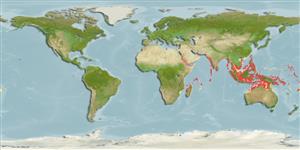Environment: milieu / climate zone / depth range / distribution range
Ecology
Marine; freshwater; brackish; pelagic-neritic; anadromous (Ref. 51243); depth range 0 - 50 m (Ref. 188). Tropical; 24°N - 0°, 69°E - 118°E (Ref. 188)
Indo-Pacific: Indian Ocean (Bombay to eastern coasts of India; perhaps east to Andaman Sea coasts, but no certain records), South China Sea (northwestern coasts of Kalimantan, also Sarawak).
Size / Weight / Age
Maturity: Lm ? range ? - ? cm
Max length : 22.0 cm SL male/unsexed; (Ref. 7050)
Dorsal spines (total): 0; Anal spines: 0; Anal soft rays: 46 - 52. Body moderately slender, belly with 23 to 26 + 11 to 13, total 34 to 38 scutes. Eye large, lower jaw projecting. Dorsal fin origin at about midpoint of body or a little behind; anal fin origin below dorsal fin base. Swim bladder with a single long tube passing back down right side of body above anal fin base.
Occurs in coastal waters, apparently entering estuaries. More data needed, based on better identifications than in the past.
Life cycle and mating behavior
Maturity | Reproduction | Spawning | Eggs | Fecundity | Larvae
Whitehead, P.J.P., 1985. FAO Species Catalogue. Vol. 7. Clupeoid fishes of the world (suborder Clupeoidei). An annotated and illustrated catalogue of the herrings, sardines, pilchards, sprats, shads, anchovies and wolf-herrings. FAO Fish. Synop. 125(7/1):1-303. Rome: FAO. (Ref. 188)
IUCN Red List Status (Ref. 130435: Version 2024-1)
Threat to humans
Harmless
Human uses
Fisheries: subsistence fisheries
Tools
Special reports
Download XML
Internet sources
Estimates based on models
Preferred temperature (Ref.
123201): 27 - 29.2, mean 28.5 °C (based on 1008 cells).
Phylogenetic diversity index (Ref.
82804): PD
50 = 0.5000 [Uniqueness, from 0.5 = low to 2.0 = high].
Bayesian length-weight: a=0.01023 (0.00520 - 0.02014), b=3.06 (2.89 - 3.23), in cm total length, based on LWR estimates for this species & Genus-body shape (Ref.
93245).
Trophic level (Ref.
69278): 3.5 ±0.5 se; based on size and trophs of closest relatives
Resilience (Ref.
120179): High, minimum population doubling time less than 15 months (Preliminary K or Fecundity.).
Fishing Vulnerability (Ref.
59153): Low vulnerability (17 of 100).
